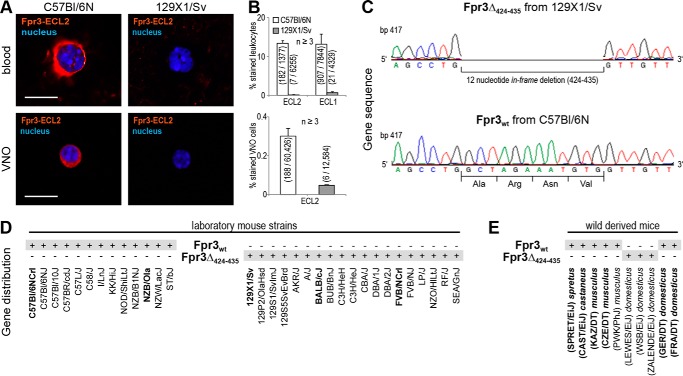FIGURE 5.
Strain-specific loss of Fpr3 expression in mice. A, representative immunostainings of Fpr3 expression in leukocytes and vomeronasal cells of C57Bl/6NCrl mice (left) versus 129X1/Sv mice (right). Fpr3 is only detectable in cells from C57Bl/6NCrl mice. Scale bars, 10 μm. B, quantifications of Fpr3 expression in leukocytes (upper panel) and vomeronasal cells (lower panel). Bar charts show average percentage of stained cells from at least three independent experiments. Numbers in parentheses denote positive versus total cells. Error bars, S.D. C, genotyping of Fpr3 in 129/Sv and C57Bl/6NCrl mice revealed two receptor variants Fpr3wt and Fpr3Δ424–435. A 12 nucleotide in-frame deletion from base pair 424 to 435 was observed in 129X1/Sv mice resulting in a loss of an alanine, arginine, asparagine, and valine at the end of the second intracellular loop. Identical results were obtained from three individuals of each strain. D, distribution of both Fpr3 gene variants in different laboratory mouse strains. Gray shading denotes the genomically encoded variants. Bold letters annotate in house sequenced strains. All other data were obtained from the Mouse Genomes Project. E, distribution of both Fpr3 gene variants in wild type-derived mouse strains from different subspecies and geographical origins. M. musculus castaneus were from Thailand (CAST/EiJ). M. musculus domesticus were from Germany (GER/DT), France (FRA/DT), the United States of America (LEWES/EiJ, WSB/EiJ), and Switzerland (ZALENDE/EiJ). M. musculus musculus were from Kazakhstan (KAZ/DT) and Czech Republic (CZE/DT, PWK/PhJ), M. musculus spretus were from Spain (SPRET/EiJ).

